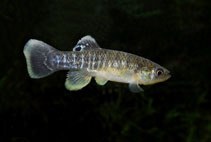| Family: |
Fundulidae (Topminnows and killifishes) |
| Max. size: |
15 cm TL (male/unsexed); max. reported age: 4 years |
| Environment: |
benthopelagic; freshwater; brackish; marine, non-migratory |
| Distribution: |
Western Atlantic: Gulf of St. Lawrence to northeast Florida, USA. Two subspecies were previously recognized: Fundulus heteroclitus heteroclitus and Fundulus heteroclitus macrolepidotus (Ref. 86798). Introduced to southern Portugal and southern Spain (Ref. 59043). |
| Diagnosis: |
Distinguished from nearly identical species Fundulus grandis by having the following characters: more convex upper profile; dark bars alternating with silvery interspaces on side; small ocellus at rear of dorsal fin of male; and each mandible with 4 pores (Ref. 86798). |
| Biology: |
Occurs in saltwater marshes, tidal creeks and nearby fresh water (Ref. 86798). A resident intertidal species with homing behavior (Ref. 32612). Adults are mainly found in saltwater marshes and in tidal creeks. They may leave tide pools if aquatic conditions become inhospitable (Ref. 31184). They also enter fresh water to a limited extent (Ref. 7251). Not a seasonal killifish. They breathe air when out of water (Ref. 31184). Difficult to maintain in aquariums (Ref. 27139). Introduction has caused the decline of native species and near extinction of Aphanius baeticus in southwestern Spain (Ref. 59043). |
| IUCN Red List Status: |
Least Concern (LC); Date assessed: 01 February 2012 Ref. (130435)
|
| Threat to humans: |
harmless |
Source and more info: www.fishbase.org. For personal, classroom, and other internal use only. Not for publication.
